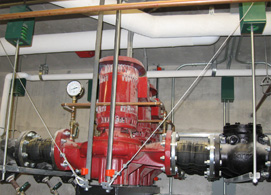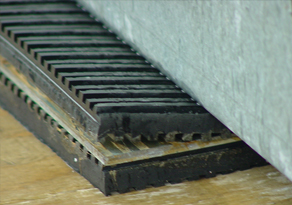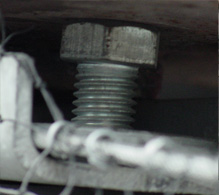
 If any spring is to isolate a mass many variables must be considered. The weight of the mass, the amount of deflection, and the frequency of vibration are three examples. Every spring naturally vibrates at a frequency depending on the amount of deflection and stiffness; this is called the spring’s resonant frequency.
If any spring is to isolate a mass many variables must be considered. The weight of the mass, the amount of deflection, and the frequency of vibration are three examples. Every spring naturally vibrates at a frequency depending on the amount of deflection and stiffness; this is called the spring’s resonant frequency.
To use a spring to isolate a mass from the load bearing surface the spring must have a resonant frequency much lower then the frequency the mass is vibrating at. For example, if a large air handling unit is vibrating at 50 Hz, the springs used to isolate it must naturally resonant much lower than that.
If springs were added that resonant at the same frequency the mass was vibrating they would in fact amplify the vibration making the situation much worse. If springs were added that resonant at a frequency much higher than the mass was vibrating they would have no effect.
The resonant frequency of a spring is dependant on the amount of deflection and the stiffness. If a mass was very heavy, a spring could be chosen that deflects less and is stiffer.
If the mass was very light, the spring could deflect more and be less stiff. This means there is a lower limit to how light a mass can be before a spring system will not be a practical isolation method.
For example, if we were trying to isolate a computer monitor from vibration using a spring system the amount of deflection and the low stiffness needed would leave the monitor sensitive to the slightest movement and completely unstable.
When the weight of the mass is appropriate, the method of reducing the amount of energy and displacement transmitted to the surface below the equipment is to install an elastic element between the equipment and the bearing surface. This elastic element is characterized by its constant k<N/m> and rated load <kg> or <lbs>. The target in design is to select such an elastic element that its natural vibration frequency is several times lower than the disturbing frequency. This selection will provide a theoretical efficiency given by the following equation:

Where:
E- percentage of vibration isolated
fd- Disturbing frequency of the isolated machine
fn- Natural frequency of the isolated machine fn<Hz>=15.8/(d st)0.5 where d st is the static deflection of the elastic element in <mm>
For a 1" static deflection we will have a 3.14 Hz natural frequency that will isolate 98% of the vibratory force of a piece of equipment running at 1800 rpm located at the ground level. This is the common vibration isolation selection for equipment designed to be installed on ground or on a perfectly rigid surface.
The equation (1) is based on the assumption that the deflection in the vibration isolator is extremely large as compared to the floor deflection, and that the moving mass of isolated equipment is extremely small as compared to the floor mass.
When the vibrating equipment is installed on a floor at an upper story location the floor has a mass and a spring rate of its own. To account for the floor deflection the selected vibration isolator should have a deflection at least 6.5 times higher than the deflection of the floor.
For example if the equipment is located on a 20 ft bay the floor deflection might be as much as 1/360 x 240" = 0.66". Then the vibration isolator should have a minimum static deflection of 4.25".
It is obvious that using a vibration isolator that has a static deflection of 1" will be very good at ground level but will do nothing for the floor isolation at an upper level installation.
 The need for higher deflection materials has caused reclassification of products: Pad materials, such as neoprene, cork, combinations of cork and neoprene, fiberglass, sisal fibers, felt, lead or any other material, provide limited deflection. These deflections are normally 10-20% of the pads thickness. Therefore, pads are good for high frequency noise breaks, and since their deflections are almost small in comparison to upper floor deflections, their use should generally be confined to basement areas, non-critical jobs or situations where job costs must be kept to an absolute minimum regardless of performance.
The need for higher deflection materials has caused reclassification of products: Pad materials, such as neoprene, cork, combinations of cork and neoprene, fiberglass, sisal fibers, felt, lead or any other material, provide limited deflection. These deflections are normally 10-20% of the pads thickness. Therefore, pads are good for high frequency noise breaks, and since their deflections are almost small in comparison to upper floor deflections, their use should generally be confined to basement areas, non-critical jobs or situations where job costs must be kept to an absolute minimum regardless of performance.
Neoprene mountings fall into the 0.2" to 0.5" deflection range. They do provide sufficient static deflection to offer protection under small high-speed equipment such as close coupled pumps up to 3 HP, vent sets, small heating ventilating units, etc., where the unbalanced forces are so small that in all probability only a noise break and minor vibration relief need be provided.

Steel spring mountings are by far the most widely used commodity on critical jobs today. Steel springs are practical through 5" of static deflection and even more on specific occasions. Springs provide an easily variable design medium, and steel spring installations are as permanent as the machine itself when selections are made within proper stress values. Most modern isolators are simply steel springs that have been designed with large enough diameters to provide stability without the need for a supplementary, often detrimental housing.
They are generally manufactured with an adjustment bolt and a pad made of neoprene or some other material in series with the spring to attenuate the high frequencies. Environmental noise testing can be done for many types of noise and vibration. Design solutions vary from enclosures, noise barriers or fencing, muffler or silencer design for the device and vibration isolation.